cross culture跨文化考试笔记
- 格式:rtf
- 大小:910.15 KB
- 文档页数:13
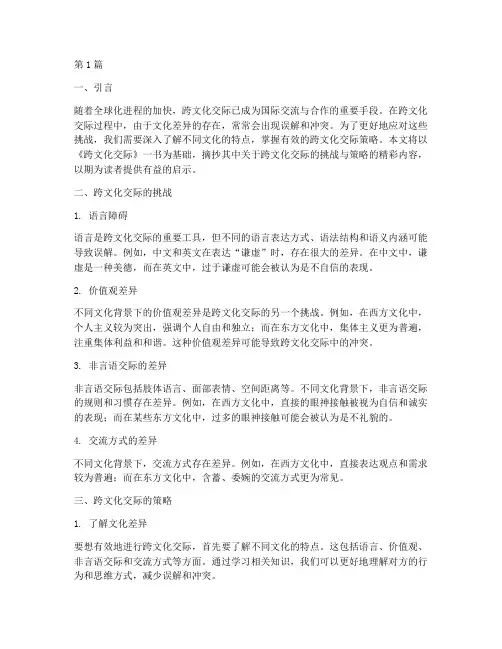
第1篇 一、引言 随着全球化进程的加快,跨文化交际已成为国际交流与合作的重要手段。在跨文化交际过程中,由于文化差异的存在,常常会出现误解和冲突。为了更好地应对这些挑战,我们需要深入了解不同文化的特点,掌握有效的跨文化交际策略。本文将以《跨文化交际》一书为基础,摘抄其中关于跨文化交际的挑战与策略的精彩内容,以期为读者提供有益的启示。
二、跨文化交际的挑战 1. 语言障碍 语言是跨文化交际的重要工具,但不同的语言表达方式、语法结构和语义内涵可能导致误解。例如,中文和英文在表达“谦虚”时,存在很大的差异。在中文中,谦虚是一种美德,而在英文中,过于谦虚可能会被认为是不自信的表现。
2. 价值观差异 不同文化背景下的价值观差异是跨文化交际的另一个挑战。例如,在西方文化中,个人主义较为突出,强调个人自由和独立;而在东方文化中,集体主义更为普遍,注重集体利益和和谐。这种价值观差异可能导致跨文化交际中的冲突。
3. 非言语交际的差异 非言语交际包括肢体语言、面部表情、空间距离等。不同文化背景下,非言语交际的规则和习惯存在差异。例如,在西方文化中,直接的眼神接触被视为自信和诚实的表现;而在某些东方文化中,过多的眼神接触可能会被认为是不礼貌的。
4. 交流方式的差异 不同文化背景下,交流方式存在差异。例如,在西方文化中,直接表达观点和需求较为普遍;而在东方文化中,含蓄、委婉的交流方式更为常见。
三、跨文化交际的策略 1. 了解文化差异 要想有效地进行跨文化交际,首先要了解不同文化的特点。这包括语言、价值观、非言语交际和交流方式等方面。通过学习相关知识,我们可以更好地理解对方的行为和思维方式,减少误解和冲突。 2. 培养跨文化意识 跨文化意识是指在面对不同文化时,能够意识到文化差异的存在,并尊重和理解对方的文化背景。培养跨文化意识有助于我们更好地应对跨文化交际中的挑战。
3. 主动沟通与交流 在跨文化交际中,主动沟通与交流是解决问题的关键。通过积极倾听、提问和反馈,我们可以更好地理解对方,避免误解和冲突。
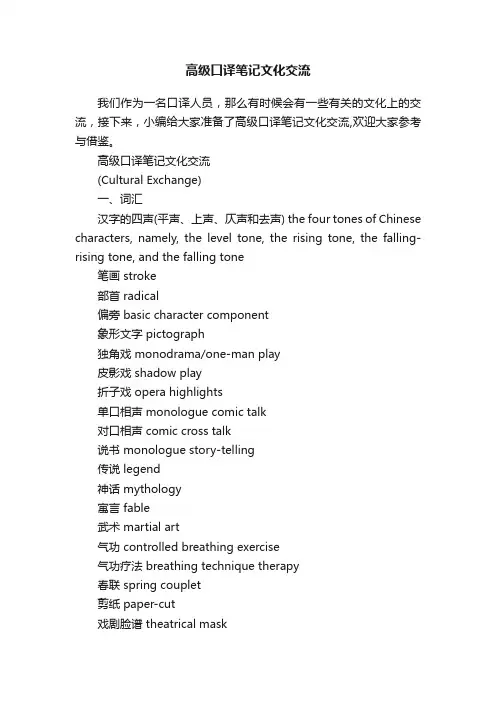
高级口译笔记文化交流我们作为一名口译人员,那么有时候会有一些有关的文化上的交流,接下来,小编给大家准备了高级口译笔记文化交流,欢迎大家参考与借鉴。
高级口译笔记文化交流(Cultural Exchange)一、词汇汉字的四声(平声、上声、仄声和去声) the four tones of Chinese characters, namely, the level tone, the rising tone, the falling-rising tone, and the falling tone笔画 stroke部首 radical偏旁 basic character component象形文字 pictograph独角戏 monodrama/one-man play皮影戏 shadow play折子戏 opera highlights单口相声 monologue comic talk对口相声 comic cross talk说书 monologue story-telling传说 legend神话 mythology寓言 fable武术 martial art气功 controlled breathing exercise气功疗法 breathing technique therapy春联 spring couplet剪纸 paper-cut戏剧脸谱 theatrical mask草药的四气:寒、热、温、凉four properties of medicinal herb: cold, hot, warm and cool草药的五味:酸、苦、甘、辛、咸 five tastes of medicinal herb: sour, bitter, sweet, hot and salty二十四节气 the twenty-four solar terms天干地支 the heavenly stems and earthly branches清明节 the Pure Brightness Day端午节 the Dragon Boat Festival中秋节 the Mid-Autumn Festival文化事业 cultural undertaking民族文化 national culture民间文化 folk culture乡土文化 native/country culture跨文化交流 cross-cultural communication文化冲击 culture shock表演艺术 performing art舞台艺术 stage art流行艺术 popular/pop art高雅艺术 elegant/high art电影艺术 cinematographic art十四行诗 sonnet三幕六场剧 a three-act and six-scene play音乐舞台剧 musical复活节 Easter万圣节 Halloween内容与形式的统一 unity of content and form古为今用,洋为中用。
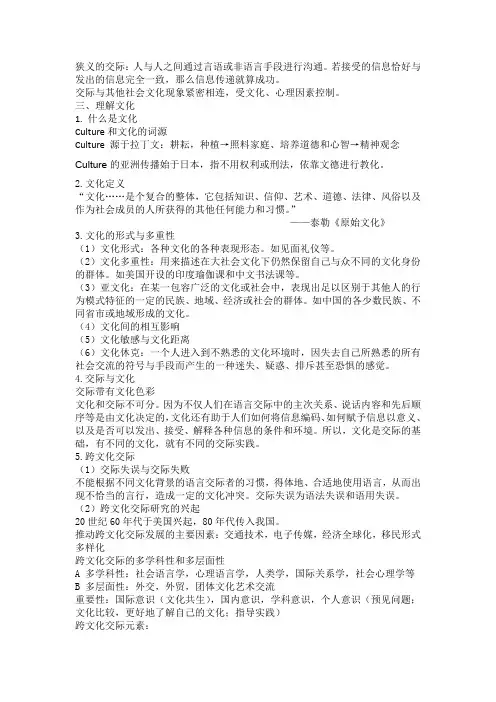
狭义的交际:人与人之间通过言语或非语言手段进行沟通。
若接受的信息恰好与发出的信息完全一致,那么信息传递就算成功。
交际与其他社会文化现象紧密相连,受文化、心理因素控制。
三、理解文化1. 什么是文化Culture和文化的词源Culture 源于拉丁文:耕耘,种植→照料家庭、培养道德和心智→精神观念Culture的亚洲传播始于日本,指不用权利或刑法,依靠文德进行教化。
2.文化定义“文化……是个复合的整体,它包括知识、信仰、艺术、道德、法律、风俗以及作为社会成员的人所获得的其他任何能力和习惯。
”——泰勒《原始文化》3.文化的形式与多重性(1)文化形式:各种文化的各种表现形态。
如见面礼仪等。
(2)文化多重性:用来描述在大社会文化下仍然保留自己与众不同的文化身份的群体。
如美国开设的印度瑜伽课和中文书法课等。
(3)亚文化:在某一包容广泛的文化或社会中,表现出足以区别于其他人的行为模式特征的一定的民族、地域、经济或社会的群体。
如中国的各少数民族、不同省市或地域形成的文化。
(4)文化间的相互影响(5)文化敏感与文化距离(6)文化休克:一个人进入到不熟悉的文化环境时,因失去自己所熟悉的所有社会交流的符号与手段而产生的一种迷失、疑惑、排斥甚至恐惧的感觉。
4.交际与文化交际带有文化色彩文化和交际不可分。
因为不仅人们在语言交际中的主次关系、说话内容和先后顺序等是由文化决定的,文化还有助于人们如何将信息编码、如何赋予信息以意义、以及是否可以发出、接受、解释各种信息的条件和环境。
所以,文化是交际的基础,有不同的文化,就有不同的交际实践。
5.跨文化交际(1)交际失误与交际失败不能根据不同文化背景的语言交际者的习惯,得体地、合适地使用语言,从而出现不恰当的言行,造成一定的文化冲突。
交际失误为语法失误和语用失误。
(2)跨文化交际研究的兴起20世纪60年代于美国兴起,80年代传入我国。
推动跨文化交际发展的主要因素:交通技术,电子传媒,经济全球化,移民形式多样化跨文化交际的多学科性和多层面性A 多学科性:社会语言学,心理语言学,人类学,国际关系学,社会心理学等B 多层面性:外交,外贸,团体文化艺术交流重要性:国际意识(文化共生),国内意识,学科意识,个人意识(预见问题;文化比较,更好地了解自己的文化;指导实践)跨文化交际元素:认知要素:“个体对来自外部世界的刺激进行选择、评估和组织的过程。
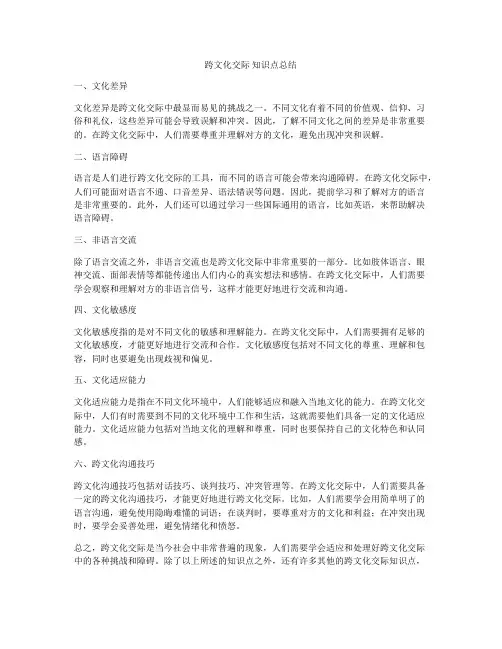
跨文化交际知识点总结一、文化差异文化差异是跨文化交际中最显而易见的挑战之一。
不同文化有着不同的价值观、信仰、习俗和礼仪,这些差异可能会导致误解和冲突。
因此,了解不同文化之间的差异是非常重要的。
在跨文化交际中,人们需要尊重并理解对方的文化,避免出现冲突和误解。
二、语言障碍语言是人们进行跨文化交际的工具,而不同的语言可能会带来沟通障碍。
在跨文化交际中,人们可能面对语言不通、口音差异、语法错误等问题。
因此,提前学习和了解对方的语言是非常重要的。
此外,人们还可以通过学习一些国际通用的语言,比如英语,来帮助解决语言障碍。
三、非语言交流除了语言交流之外,非语言交流也是跨文化交际中非常重要的一部分。
比如肢体语言、眼神交流、面部表情等都能传递出人们内心的真实想法和感情。
在跨文化交际中,人们需要学会观察和理解对方的非语言信号,这样才能更好地进行交流和沟通。
四、文化敏感度文化敏感度指的是对不同文化的敏感和理解能力。
在跨文化交际中,人们需要拥有足够的文化敏感度,才能更好地进行交流和合作。
文化敏感度包括对不同文化的尊重、理解和包容,同时也要避免出现歧视和偏见。
五、文化适应能力文化适应能力是指在不同文化环境中,人们能够适应和融入当地文化的能力。
在跨文化交际中,人们有时需要到不同的文化环境中工作和生活,这就需要他们具备一定的文化适应能力。
文化适应能力包括对当地文化的理解和尊重,同时也要保持自己的文化特色和认同感。
六、跨文化沟通技巧跨文化沟通技巧包括对话技巧、谈判技巧、冲突管理等。
在跨文化交际中,人们需要具备一定的跨文化沟通技巧,才能更好地进行跨文化交际。
比如,人们需要学会用简单明了的语言沟通,避免使用隐晦难懂的词语;在谈判时,要尊重对方的文化和利益;在冲突出现时,要学会妥善处理,避免情绪化和愤怒。
总之,跨文化交际是当今社会中非常普遍的现象,人们需要学会适应和处理好跨文化交际中的各种挑战和障碍。
除了以上所述的知识点之外,还有许多其他的跨文化交际知识点,比如文化适应、文化冲突解决等等。
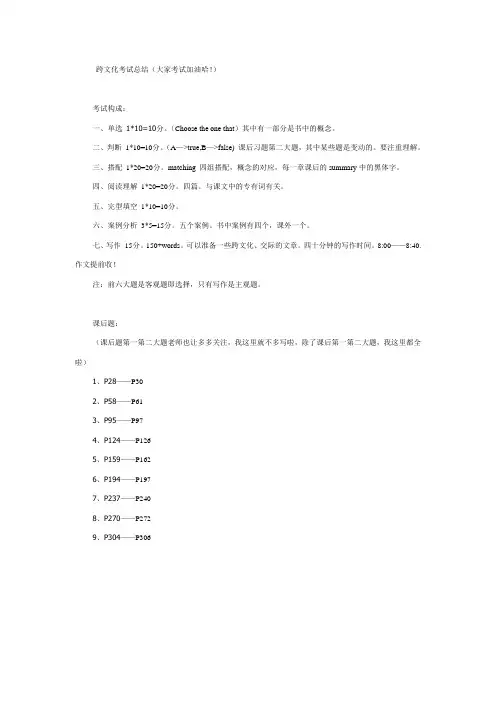
跨文化考试总结(大家考试加油哈!)考试构成:一、单选1*10=10分。
(Choose the one that)其中有一部分是书中的概念。
二、判断1*10=10分。
(A—>true,B—>false) 课后习题第二大题,其中某些题是变动的。
要注重理解。
三、搭配1*20=20分。
matching 四组搭配,概念的对应,每一章课后的summary中的黑体字。
四、阅读理解1*20=20分。
四篇。
与课文中的专有词有关。
五、完型填空1*10=10分。
六、案例分析3*5=15分。
五个案例。
书中案例有四个,课外一个。
七、写作15分。
150+words。
可以准备一些跨文化、交际的文章。
四十分钟的写作时间。
8:00——8:40.作文提前收!注:前六大题是客观题即选择,只有写作是主观题。
课后题:(课后题第一第二大题老师也让多多关注,我这里就不多写啦,除了课后第一第二大题,我这里都全啦)1、P28——P302、P58——P613、P95——P974、P124——P1265、P159——P1626、P194——P1977、P237——P2408、P270——P2729、P304——P306所有概念关键词+考试范围内的CASE:Chapter 1 CultureKeywords(1) Culture (from intellectual perspective): Culture is “the arts and other manifestations of human intellectual achievement regarded collectively”(从知性角度定义文化:作为整体的人类智力成就的艺术和其他表现。
)(2) Culture (from anthropologic perspective): Culture consists of patterns, explicit and implicit, of and for behavior acquired and transmitted by symbols, constituting the distinctive achievement of human groups, including their embodiments in artifacts; the essential core of culture consists of traditional ideas and especially their attached values”.(从人类学角度定义文化:文化由清晰和模糊的行为模式构成,这些模式通过符号获得并传播,这些符号由人类群体的特别成就构成,包括具体的人工制品。
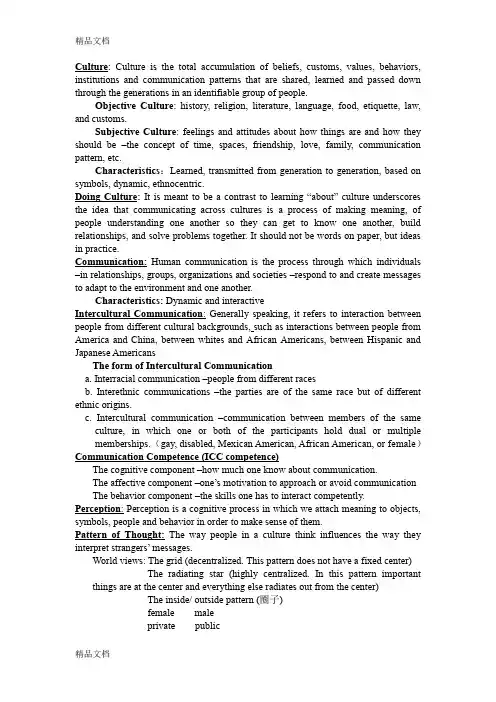
Culture: Culture is the total accumulation of beliefs, customs, values, behaviors, institutions and communication patterns that are shared, learned and passed down through the generations in an identifiable group of people.Objective Culture: history, religion, literature, language, food, etiquette, law, and customs.Subjective Culture: feelings and attitudes about how things are and how they should be –the concept of time, spaces, friendship, love, family, communication pattern, etc.Characteristics:Learned, transmitted from generation to generation, based on symbols, dynamic, ethnocentric.Doing Culture: It is meant to be a contrast to learning “about” culture underscores the idea that communicating across cultures is a process of making meaning, of people understanding one another so they can get to know one another, build relationships, and solve problems together. It should not be words on paper, but ideas in practice.Communication: Human communication is the process through which individuals –in relationships, groups, organizations and societies –respond to and create messages to adapt to the environment and one another.Characteristics: Dynamic and interactiveIntercultural Communication: Generally speaking, it refers to interaction between people from different cultural backgrounds, such as interactions between people from America and China, between whites and African Americans, between Hispanic and Japanese AmericansThe form of Intercultural Communicationa. Interracial communication –people from different racesb. Interethnic communications –the parties are of the same race but of different ethnic origins.c. Intercultural communication –communication between members of the sameculture, in which one or both of the participants hold dual or multiple memberships.(gay, disabled, Mexican American, African American, or female)Communication Competence (ICC competence)The cognitive component –how much one know about communication.The affective component –one’s motivation to approach or avoid communication The behavior component –the skills one has to interact competently. Perception: Perception is a cognitive process in which we attach meaning to objects, symbols, people and behavior in order to make sense of them.Pattern of Thought: The way people in a culture think influences the way they interpret strangers’ messages.World views: The grid (decentralized. This pattern does not have a fixed center) The radiating star (highly centralized. In this pattern important things are at the center and everything else radiates out from the center)The inside/ outside pattern (圈子)female maleprivate publichome market, mosque, coffee housethe outside is plain, not welcoming, even forbidding. The walls are thick to protect what is inside.highly centralized pattern: important people sit in the front middle;decentralized pattern: people sit equally.Stereotyping: People generalize to make sense of his experience. The result of the process of over generalizing based on limited or inaccurate information.The classification of stereotypes1. Negative stereotype of other cultures: Prejudice (severe prejudice)2. Positive stereotype of one’s own culture: Cultural superiority Characteristics: universal, unavoidable, stable, variable, ethnocentrismHigh context communication & Low context communicationHC culture (察言观色): Relies mainly on the physical context or the relationship for information, with little explicitly encoded.LC culture: provide most of the information in the explicit code itself.Perception: Perception is a cognitive process in which we attach meaning to objects, symbols, people and behavior in order to make sense of them.High contact and low contact culture:In high contact cultures people want to get close enough to one another and to objects to sense them in these ways.People in these countries stand closer, touch more, engage in more eye contact and speak more loudly than people do in lower-contact cultures.In a low contact cultures, people rely more on sight, and especially sight at a far distance. People are most likely to stand a certain distance away to get the whole picture, without actually feeling or sensing the other person’s body heat or subtle smell. So in low contact culture as America, one is taught not to breathe on people.However, this visual space seems unfriendly and indifferent to those from high contact cultures, which favor tactile space.When a person from a high contact culture goes to a low contact culture, he or she is likely to feel that people are cold, lack human warmth, and are indifferent and pay no attention to them.low-contact: Asia ; moderate-contact: Australia, Northern Europe, United States high-contact: South America, Mediterranean, the Arab worldLarge and smell Power Distancespower distance is an attempt to measure cultural attitudes about inequality insocial relationships.In high power distance cultures, position in a hierarchy is considered to benatural and important. People are expected to show only positive emotions toothers with high status and to display negative emotions to those with low status;tend to decrease gaze in the presence of powerful people.Low Power Distance Culture: Minimize and eliminate the differences in power and status; more emotional display, increase the amount of gaze. People believe that the differences in power between boss and workers should be reduced and not mphasized.Individualism VS CollectivismThe individualism index measures the extent to which the interests of the individual are considered to be more important than the interests of the group. People from individualist cultures are more likely to act on principles that apply to everyone, principles that are universal and apply to associates and strangers alike. Collectivists are not unprincipled, but when making decisions they tend to give a higher priority to relationships than individualists do. They expect people who are involved in a group relationship to have duties and obligations to one another. Masculinity (Toughness) VS Femininity (Tenderness)Masculinity means everyone in society embraces values that have traditionally been associated with men, that is assertiveness, competitiveness and toughness. On the feminine side of the scale we find societies in which people generally embrace values that have traditionally been labeled as feminine, that is modesty, cooperation and tenderness.Strong and weak Uncertainty AvoidanceThe Uncertainty Avoidance Index seeks to measure the extent to which people in a particular society are able to tolerate the unknowns of life. In high uncertainty avoidance countries people experience more stress and a sense of urgency as they go through their daily routines. Relationships are guided by strict rules. People from low uncertainly avoidance countries do not have a strong need to control things, people, and events by clearly defining and categorizing them. Relationships are guided by strict rules.Intercultural CommunicationIntercultural CommunicationGenerally speaking, it refers to interaction between people from different cultural backgrounds, such as interactions between people from America and China, between whites and African Americans, between Hispanic and Japanese Americans The form of Intercultural Communicationa. Interracial communication –people from different racesb. Interethnic communications –the parties are of the same race but of different ethnic origins.c. Intracultural communication –communication between members of the sameculture, in which one or both of the participants hold dual or multiple memberships.(gay, disabled, Mexican American, African American, or female)Language&CulturePeople pay attention to basic language in cross-culture communication because of the essential role these codes play in communication and they are part of object culture. The same word may stir up different associations in people under different cultural background, e.g. the word “dog”. In eastern culture, dogs are dirty, brutal and stupid. But in western culture, dogs are lovely, loyal and obedient. They are faithful friends and compassionate animals.Language reflects culture. Language expresses cultural reality, reflects the people’s attitudes, beliefs, world outlooks, etc. For example, American businessmen often encode their meanings in metaphors and images from these sports.Chinese traditional sport culture emphasizes the harmony between human beings and oneness between man and nature. It is morality, benevolence, entertainment and longevity. But western sports culture is competition and sportsmanship.Culture shock: Troublesome feelings such as depression, loneliness, confusion, inadequacy, hostility, frustration, and tension, caused by the loss of familiar cues from the home culture.U-Curuemodel:Excitement→Confusion→Frustration→Effectiveness→Appreciation。
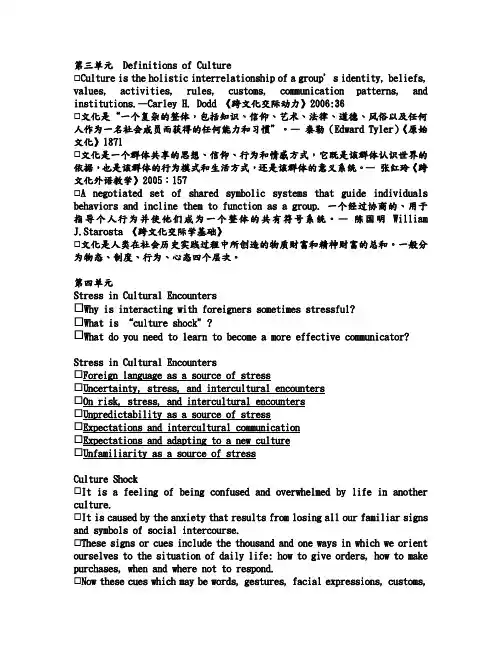
第三单元Definitions of Culture☐Culture is the holistic interrelationship of a group’s identity, beliefs, values, activities, rules, customs, communication patterns, and institutions.—Carley H. Dodd 《跨文化交际动力》2006:36☐文化是“一个复杂的整体,包括知识、信仰、艺术、法律、道德、风俗以及任何人作为一名社会成员而获得的任何能力和习惯”。
—泰勒(Edward Tyler)《原始文化》1871☐文化是一个群体共享的思想、信仰、行为和情感方式,它既是该群体认识世界的依据,也是该群体的行为模式和生活方式,还是该群体的意义系统。
—张红玲《跨文化外语教学》2005:157☐A negotiated set of shared symbolic systems that guide individuals behaviors and incline them to function as a group. 一个经过协商的、用于指导个人行为并使他们成为一个整体的共有符号系统。
—陈国明William J.Starosta 《跨文化交际学基础》☐文化是人类在社会历史实践过程中所创造的物质财富和精神财富的总和。
一般分为物态、制度、行为、心态四个层次。
第四单元Stress in Cultural Encounters☐Why is interacting with foreigners sometimes stressful?☐What is “culture shock”?☐What do you need to learn to become a more effective communicator?Stress in Cultural Encounters☐Foreign language as a source of stress☐Uncertainty, stress, and intercultural encounters☐On risk, stress, and intercultural encounters☐Unpredictability as a source of stress☐Expectations and intercultural communication☐Expectations and adapting to a new culture☐Unfamiliarity as a source of stressCulture Shock☐It is a feeling of being confused and overwhelmed by life in another culture.☐It is caused by the anxiety that results from losing all our familiar signs and symbols of social intercourse.☐These signs or cues include the thousand and one ways in which we orient ourselves to the situation of daily life: how to give orders, how to make purchases, when and where not to respond.☐Now these cues which may be words, gestures, facial expressions, customs, or norms are acquired by all of us in the course of growing up and are as much a part of our culture as the language we speak or the beliefs we accept. All of us depend for our peace of mind and efficiency on hundreds of these cues, most of which we are not consciously aware.Causes of cultural shock☐Loss of control☐Being deprived of familiar and loved things and people☐Physical, mental, and emotional fatigue (culture fatigue)☐Discrepant expectations, lack of social support and in sufficient social skillsSymptoms of culture shock☐Homesickness☐Boredom☐Withdrawal☐Need for excessive amount of sleep☐Compulsive eating and/ or drinking☐Irritability☐Exaggerated cleaniness☐Marital stress, family tension and conflict☐Chauvinistic excesses第五六单元Projected Cultural Similarity☐The tendency to assume that people from other cultures basically think and feel more or less the same way we do.☐There are sufficient similarities among peoples of the world to make communication easy.☐Once you get used to their different (dress, manners, style) they are just like us. ☐Denial, defense, minimization, acceptance, adaptation, and integration. (Ethnocentrism)Projected Cultural Similarity☐The Golden Rule: Do unto others what you would have them do unto you./ Do as you would be done by.☐Do not unto others what you would not be done by. 己所不欲勿施于人☐Expecting others to be the same as we are/do the same as we do☐Culture shock☐Frustration☐Wince☐Other Obstacles: Stereotype, ethnocentrismEthnocentrism☐Assuming that the world-view of one’s own culture is central to all reality, the idea that your own race, nation, group etc is better than any other☐Obstacle that leads to distrust, conflict, even hostilityEthnorelativism☐Maintaining that cultures can only be understood relative to one another; there is no absolute standard of rightness or goodness that can be applied to culturalbehavior; cultural difference is neither good nor bad; it is just different. Accepting and allowing difference to be difference.Comparing Communication styles☐Direct – indirect☐Linear – circular☐Self-enhancement – self-effacement☐Talk – silence☐Succinct –elaborate☐Person- and task- oriented – relation- and status-orientedHigh context communication☐Collectivists are expected to “read the other’s mind” during communication, so the message is quite indirect, dependent on hints, the use of the eyes, distance between bodies, and so on.☐In speech, collectivists employ ‘we’ more often and they depend on context (tone of voice, gesture, posture, etc.) to convey meaning.Low context communication☐In speech, individualists tend to use ‘I’ and emphasize content.☐Individualists say what is on their minds, even if it risks damaging the relationship.☐Americans, valuating pragmatic action, are quick to come to the point in conversations.☐The responsibility for meaning falls mainly to the speakers, whose job it is to formulate ideas into clear language. The more lucid speakers are the more highly regarded they are as communicators.Looseness vs. Tightness☐“Loose” cultures do not demand a high degree of conformity.☐“Tight” cultures exp ect a relatively high degree of conformity.☐Individualist cultures tend to be “looser” than collectivist cultures.☐The Middle of the road/Golden mean/Happy medium/via mediaEthnocentrism and Projected Cultural Similarity☐They are closely related, but describe somewhat different phenomena.☐Ethnocentrism is taking one’s own cultural norms as the standard by which to judge people of other cultures.☐Projected cultural similarity is assuming that people of other cultures view things the same way we do.第七单元In-groups and out-groupsWe generally have more positive feelings toward members of our in-groups than we do toward outsiders.We tend to have a stronger sense of obligation to insiders than to outsiders.We tend to judge in-groups and out-groups by different standards.For better communication, we need to find ways to counter-balance our natural tendency to judge out-groups more harshly.第八单元Dealing with conflict☐Collectivists and preservation of harmony: Collectivists want their in-groups to be monolithic and homogeneous—with everyone thinking, feeling, and acting in the same way; they think that in such groups, there will be harmony. They feel more comfortable than individualists in the presence of like-minded others. Individualists emphasize harmony less and often think that an argument clears the air.Dealing with conflict☐Honesty vs. tact: collectivists often find themselves in a dilemma when they have to communicate an unpleasant message. Although they value honesty, theyvalue even more keeping relationships. If telling the truth means damaging a relationship, they would rather tell a white lie.Lying is an acceptable behavior in collectivist cultures, especially if it saves face or benefits the ingroup. In contrast, individualists see lying as breaking the contract, and since contracts are very important, this is a serious offense.Dealing with conflict☐American directness:When faced with a problem, Americans like to get to its source. This means facing the facts, meeting the problem heed on, putting the cards on the table, and getting information “straight from the horse’s mouth.” Consistent with these tendencies, it is also desirable to face people directly —to confront them. Confrontation is not necessarily rancorous, but it does involv e reporting one’s feelings honestly, expecting reciprocal honesty, and dealing with the person involved in the problem.Dealing with conflict☐American directness:There is also, however, a strong need to preserve “surface cordiality.” In communication, Americans (especially white middle-class) tend not to express strong emotions. Americans also abide by a strong convention to preserve surface cordiality in social interactions. Kind words and pleasant smiles are natural and expected; sharp opinions and critical positions in face-to-face encounters are avoided for fear of disrupting social conviviality.Dealing with conflict☐American views of conflict:At the root of the American confrontation style is the concept that adversaries can compete against each other and at the same time cooperate under the rules for interpersonal conflict.☐Chinese and harmony:Harmony is the foundation of Chinese culture.Dealing with conflict☐Chinese provisional responses that allow avoidance of a direct “no”:⏹It’s not conve nient.⏹There may be some difficulties.⏹The problem isn’t too big.⏹We should study this.⏹We should think about this.第十单元Advice forcommunicating with westerners☐Try not to read too much into North Americans’ words or be oversensitive to nonverbal nuances. Focus on what North Americans actually say; what they say is often what they really mean.☐Be aware that self-affirmation and individuality are important to North Americans.☐Be aware that everyone should be treated equally. One should use polite speech with family members and intimate friends, and also with strangers (including store clerks, waiters, and so forth).Advice forcommunicating with westerners☐Accept that North Americans consider it good to speak directly and that requests are often stated directly and explicitly.☐Recognize that being assertive is valued in North American culture, and that “no” is accepted as an assertive — not necessarily rude — response.☐Understand that what Chinese consider modesty may be viewed by NorthAmericans as low self-confidence. Speak positively about oneself and one’s abilities is expected.Advice forcommunicating with westerners☐Be cautious about asking personal questions, because North Americans may consider them offensive and insulting. North Americans may also feel that what Chinese consider guan xin (concern) is meddling and intrusive.☐Accept that North Americans like to express their opinions openly.Usage☐to read into : to think that a situation, action etc, has a meaning or importance that it does not really have. 理解时加进(原本没有的意思)⏹You read love into her casual friendliness.⏹Don’t read more into her letter than she intend ed.⏹Just because he is so nice to you doesn’t necessarily mean he is in love with you. He is really nice to every woman he meets, so don’t read too much into it.⏹It was only a casual remark, I think you’re reading too much into it.Usage☐to read into →to read sth. into sth.; to read much into sth. 理解时加进(原本没有的意思)⏹Although it was a comedy, you could read biting social comment into the actors lines.⏹Too much should not be read into the minister’s statement: we can’t expect a sudden easing of the situation.⏹Try not to read too much into North American’s words or be oversensitive to nonverbal nuances.Things collectivists need to learn for interacting with individualists☐Tend to give priority to individual goals.☐Often base behavior on “internal attributes”.☐Are more likely to ask questions in class.☐Less willing to maintain relationships at a cost.☐May want to spend time alone, consider privacy important.☐Tend to attribute behavior to internal (personal) causes.☐Try to change social situations into which they do not fit.Things collectivists need to learn for interacting with individualists☐Are able to interact in relatively superficial social relationships, moving in and out of them.☐Need to compliment in-group members more.☐Expect competition.☐Tend to get to the point during meetings.☐Generally take contracts seriously.☐Don’t expect in-group membership to confer too many special privileges.Things East Asians should learn about (individualistic) Westerners☐Tend to have high self-esteem and need to express this.☐Are relatively enthusiastic and expressive.☐Stress pleasure, fun, and happiness.☐Decide quickly, but implement decisions more slowly because relatively few people are included in the decision making process.☐Place value on consistency between attitu des and behavior. Dislike “hypocrisy”.☐Don’t make sharp distinctions between public and private behavior.Things East Asians should learn about (individualistic) Westerners☐More likely do something because they want to than out of obligation.☐Expect clear definition of relationships. Like to use contracts.☐Expect most relationships to last a relatively short time.Strategies for Chinese☐Treating one another as equals.(平等相待)☐Mutual respect for privacy. (相互尊重私人权)☐Seeking the common ground. (求同存异)☐Placing one’s self in the other’s shoes. (换位思维)☐When negotiating with Westerners or trying to make arrangements with them, a “multiple choice” strategy should be adopted to give Westerners many options to choose from. This plays to Westerners’ individualistic tendenc ies.。
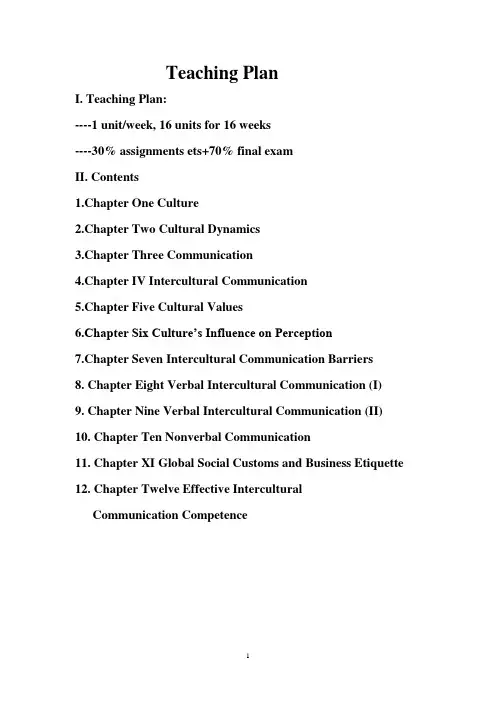
Teaching PlanI. Teaching Plan:----1 unit/week, 16 units for 16 weeks----30% assignments ets+70% final examII. Contents1.Chapter One Culture2.Chapter Two Cultural Dynamics3.Chapter Three Communication4.Chapter IV Intercultural Communication5.Chapter Five Cultural Values6.Chapter Six Culture’s Influence on Perception7.Chapter Seven Intercultural Communication Barriers8. Chapter Eight Verbal Intercultural Communication (I)9. Chapter Nine Verbal Intercultural Communication (II)10. Chapter Ten Nonverbal Communication11. Chapter XI Global Social Customs and Business Etiquette12. Chapter Twelve Effective InterculturalCommunication CompetenceChapter One CultureQuestions for discussion:1.What’s culture?(examples and definitions) some cultures.3.What’s the uses of learning a particular culture?/What doesculture can help/ Is it necessary to learn culture?( Your culture and other’s culture)4.Whom do you learn a culture from?5.Definition of culture6.Characteristics of culture7.Cultural Identity: definition and examples and formation andcharacteristics.Enculturation,acculturation,separation,segregation, integration,assimilation, marginalization ,and culture shock cultural conflict host cultureTo identify the definitions ofenculturation,ɪn kʌlt∫ə`reɪ∫ən n. 对某种文化的适应acculturation, ə kʌlt∫ə՝rei∫ən n. 文化传入, 文化适应separation,segregation, segri՝gei∫ən n. 种族隔离integration,inti՝grei∫ən n. 综合assimilation, ə sɪmɪ`leɪ∫ən ]n. 同化, 同化作用, 消化marginalization边缘化and culture shock 文化冲击cultural conflict 文化冲突host culture主文化(要学习的别人的问话)中国作为东道主文化(host culture),对于国外汉学家从事对自己文化研究的努力,一般都表现出友善和欢迎的态度。
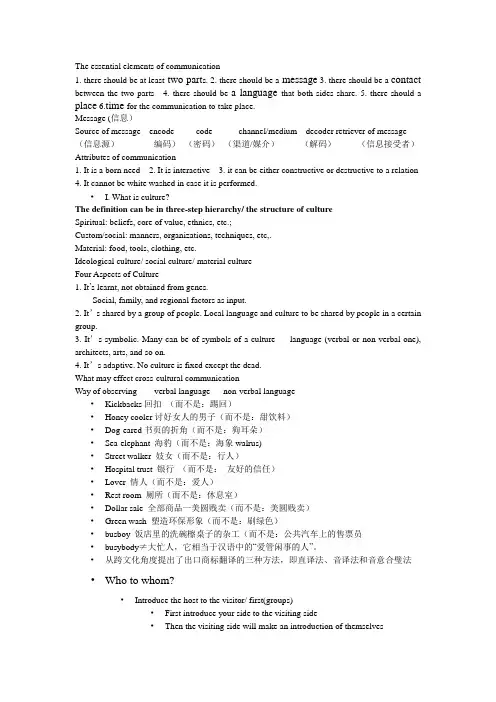
The essential elements of communication1. there should be at least two part s.2. there should be a message3. there should be a contact between the two parts4. there should be a language that both sides share.5. there should a place6.time for the communication to take place.Message (信息)Source of message encode code channel/medium decoder retriever of message (信息源)编码)(密码)(渠道/媒介)(解码)(信息接受者)Attributes of communication1. It is a born need2. It is interactive3. it can be either constructive or destructive to a relation4. It cannot be white washed in case it is performed.•I. What is culture?The definition can be in three-step hierarchy/ the structure of cultureSpiritual: beliefs, core of value, ethnics, etc.;Custom/social: manners, organizations, techniques, etc,.Material: food, tools, clothing, etc.Ideological culture/ social culture/ material cultureFour Aspects of Culture1. It’s learnt, not obtained from genes.Social, family, and regional factors as input.2. It’s shared by a group of people. Local language and culture to be shared by people in a certain group.3. It’s symbolic. Many can be of symbols of a culture --- language (verbal or non-verbal one), architects, arts, and so on.4. It’s adaptive. No culture is fixed except the dead.What may effect cross-cultural communicationWay of observing verbal language non-verbal language•Kickbacks回扣(而不是:踢回)•Honey cooler讨好女人的男子(而不是:甜饮料)•Dog-eared书页的折角(而不是:狗耳朵)•Sea-elephant 海豹(而不是:海象walrus)•Street walker 妓女(而不是:行人)•Hospital trust 银行(而不是:友好的信任)•Lover 情人(而不是:爱人)•Rest room 厕所(而不是:休息室)•Dollar sale 全部商品一美圆贱卖(而不是:美圆贱卖)•Green wash 塑造环保形象(而不是:刷绿色)•busboy 饭店里的洗碗檫桌子的杂工(而不是:公共汽车上的售票员•busybody≠大忙人,它相当于汉语中的“爱管闲事的人”。
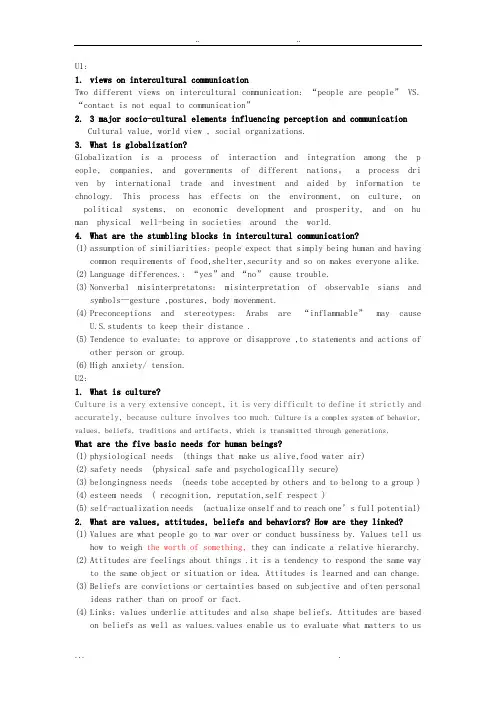
U1:1.views on intercultural communicationTwo different views on intercultural communication: “people are people” VS. “contact is not equal to communication”2. 3 major socio-cultural elements influencing perception and communicationCultural value, world view , social organizations.3.What is globalization?Globalization is a process of interaction and integration among the p eople, companies, and governments of different nations。
a process dri ven by international trade and investment and aided by information te chnology. This process has effects on the environment, on culture, on political systems, on economic development and prosperity, and on hu man physical well-being in societies around the world.4.What are the stumbling blocks in intercultural communication?(1)assumption of similiarities: people expect that simply being human and havingcommon requirements of food,shelter,security and so on makes everyone alike.(2)Language differences.: “yes”and “no” cause trouble.(3)Nonverbal misinterpretatons: misinterpretation of observable sians andsymbols—gesture ,postures, body movenment.(4)Preconceptions and stereotypes: Arabs are “inflammable”may causeU.S.students to keep their distance .(5)Tendence to evaluate: to approve or disapprove ,to statements and actions ofother person or group.(6)High anxiety/ tension.U2:1.What is culture?Culture is a very extensive concept, it is very difficult to define it strictly and accurately, because culture involves too much. Culture is a complex system of behavior, values, beliefs, traditions and artifacts, which is transmitted through generations.What are the five basic needs for human beings?(1)physiological needs (things that make us alive,food water air)(2)safety needs (physical safe and psychologicallly secure)(3)belongingness needs (needs tobe accepted by others and to belong to a group )(4)esteem needs ( recognition, reputation,self respect )(5)self-actualization needs (actualize onself and to reach one’s full potential) 2.What are values, attitudes, beliefs and behaviors? How are they linked? (1)Values are what people go to war over or conduct bussiness by. Values tell ushow to weigh the worth of something, they can indicate a relative hierarchy.(2)Attitudes are feelings about things .it is a tendency to respond the same wayto the same object or situation or idea. Attitudes is learned and can change.(3)Beliefs are convictions or certainties based on subjective and often personalideas rather than on proof or fact.(4)Links: values underlie attitudes and also shape beliefs. Attitudes are basedon beliefs as well as values.values enable us to evaluate what matters to usor apply standars to our attitudes and beliefs.value→ belief →attitude. For example , you have an attitude toward eating raw fish,which is positive and is based on the belief that expert prepararion of sushi and sashimi by Japanese chefs results in culinary delicacies ,or you have an attitude that is negative,based on the belief that raw fish can contain parasites that cause unpleasant consequences in the human digestive system. You can even have both attitudes at the same time.if you do ,then probably you value both fine eating experiences and physical health.3.What are the elements of communication?①context: physical setting, psychological ,historical,culture ,thecommunication norms②participants: senders who form messages and communicate with symbols,receiverswho process and react the massages.③Massages: meanings, symbols ,encodings and decodings④Channels :a variety of sensory channels⑤Noise ;internal external and semantic noise.⑥Feedback : the verbal and nonverbal responses4.What are norms?Norms are the guildelines that we establish for conducting transactions. Norms tell us what kinds of messages and behavior are proper in a given context or with a particular person or group of people. People acquire communication norms from their experiences in life.5.What is the difference between encoding and decoding?Encoding is the process of transforming ideas and feelings into symbols and organizing them. Decoding is the process of tansforminf meeages backe into ideas and feelings.Transforming and organizing Transforming and intepretingideas and feelings--------------------→symbols/massages------------→ideas and feelings↓↓Encoding decoding6.What is the difference between external noise, internal noise and semanticnoise?external noise : Sights and sounds and other stimuli in the environment that draw people’s attention away from intended meaning.internal noise : Thoughts and feelings that interfere with the communication process. Feelings of anger or anxiety ,stereotypeor prejudice in your mind.semantic noise: the meanings we assign to words depend on our own experience, other people may at times decode a word or phases differently from the way we intend.7.What is communication?Communication is a process involving the exchange of messages and the creation of meaning.U3:1.What are the five basic questions at the root of any culture’s value system?(1)what is the character of innate human nature?-----human nature(2)what is the relation of man to nature?------t he relationship of man to nature.(3)What is the temporal focus of human life?----sense of time /time orientation.(4)What is the mode of human activity?-------activity orientation.(5)What is the mode of human relationships?----social relationships2.What are the key principles of Confucianism?(1)social order and stability are based on uneqal relationships between peopleincluding leaders and followers ,father and son ,husband and wife , older brother and younger brother,and friends .(2)family :follow rules for ordering(3)proper social behavior consists of not treating others as you would not liketo be treated youself.,learn to be sensitive to other’s feels(子所不欲勿施于人)(4)people should be skilled ,educated hardworking,thrifty ,modest, patient andpersevering.3.How do living situations account for value differences between differentcultures?For example,Japanese live in a little of arable land ,even mainly valcanoes.thus,they built their homes together very closely in order to make use of every available land and they can work together in planting and harvesting of rice effectively . In this situation, japanenes’central social valuebecause of living close proximity that gave very little privacy was that an idividual does not matter. However, in the U.S. it is common to see a pattern of a single farmhouse surrounded by firelds.the nearnest neighbor was perhaphs two miles distant.inevitably, the central social values were self-reliance and independence.4.What are cultural values?The commonly held standards of what is acceptable or unacceptable, important or unimportant, right or wrong, good or bad, true or false, workable or unworkable, etc., in a community or society.Values represent a learned organization of rules for making choices and for resolving the conflicts.5.What are the five dimensions to consider when doing studies of culturaldifferences(culture value)?(1)Idividualism versus collectivism (involves people’s relationship stothe larger social groups;social relationship)Idividualism;key words include independence,privacy,self,and all important ICollectivism believe in obligations to the group, we consciouceness and an emphasis on belonging.(2)uncertainty avoidance(how to adapt to changes and cope withuncertainties,)Greece(plan everything0 versus Singapore (like uncertainty)(3)power distance(all people in a culture do not have equals levels ofstatus or social power.) Malaysia versus New Zealand(4)masculinity versus femininity(work harder to get achievement ,wealthversus caring for the others and the quatity of life) Japan versus Thailand(5)orientation to time (a long-term orientation schedule for work and lifeversus a short-term orientation toward changing events)6.What are the differences between a high-context culture and a low-context one? Low-context interaction emphasizes direct talk, person-oriented focus, self-enhancement mode, and the importance of “talk”: high- context interaction, in contrast stresses indirect talk, status-oriented focus , self- esffacement mode, and the importance of nonverbal signals and even silence.U4:1.What is the relationship between language and culture?Culture and language are interwined and shaped each other. Each time we select words ,form sentence, and send a message ,either oral or written,we also make cultural choices. Cultural literacy(特定领域的能力或知识) is necessary to understand the language being used.(1)all languages have social questions and information questions.For exemple: in Ameirca English ,the question “How are you”is a social question,the Americans register the phrase as “hello”. But in Germany and Russia ,the phase is an imformation qustion .the speaker atually wants to get an answer to it.(2) language reflects the environment in which we live .For exemple, in the Amazon area snow is not part of the environment. Therefore , people in that region do not have a word for snow . however , most Americans ,who live an environment where Iit snows most months of the year, use terms such as snow , sleet , slush, blizzard and ice.(3)language reflects cultural values. a way of thinking .when we translate concepts from a foreign language and cultural with words ,we have to choose the priority words in oder to communicate effectively. Cultural kowledge is impotant as linguistic knowledge.For example ,Amerians are frustrated with the manana mentality(西班牙语的明天心态) of Spanish-speaking countries : for American tomorrow means midnight to midnight ,a very precise time period , To Mexicans ,manana means in the future,soon. (4,)Different cutures use identical words that have rather different meanings. For example, for Amercans ,adminisration in the university context means department chair or dean,for Frenches adminisration means upper level clerical staff . What Americans consider to be an adminstrator, Frenches consider faulty.(5)language changes overtime.words and prases that are used commonly at one time may be discontinued or their meaning my change overtime.For example, the word gay means happy lightened. In recent decades ,however the word has taken on the meaning”homosexual”.English speaking countries do n’t use the original meaning anymore..Communication across cultures and language is difficult and full of hurdles and pitfalls. Even if two people from different countries spesk a common language ,they may misinteptet the cutural signal. If that happens ,in all likelihood , there will be a cutural problem rhather than a language problem.2.What is the relationship between environment and language?(2) language reflects the environment in which we live .For exemple, in the Amazon area snow is not part of the environment. Therefore , people in that region do not have a word for snow . however , most Americans ,who live an environment where Iit snows most months of the year, use terms such as snow , sleet , slush, blizzard and ice.3.How does language change over time?language changes overtime.words and prases that are used commonly at one time may be discontinued or their meaning my change overtime.For example, the word gay means happy lightened. In recent decades ,however the word has taken on the meaning”homosexual”.English speaking countries do n’t use the original meaning anymore..4.Denotations and connotationsDenotations: denotations of a word or phrase are the meanings that relate it to the objects or concepts referred to the actual or fictional “things”that are symbolized.For example, the denotation of the English word “bird”is a tow –legged,winged,egg-laying creature.Connnotations: connnotations refer to the additional meanings that a word or phrase has beyond its central meaning .These meanings show people’s attitudes or feelings toward what the word or phase refers to.For example: consider the word “dog” in English and 狗in Chinese. They can be said to have the same denotative meaning; however,people from different cutures may have different connotative reactions to these words ,compare “a homeless dog”(流浪狗) with 丧家之犬5.What are the ways of expressing “no”? Why do people in countries like Japanand China often refuse to say “no” directly?(1)be vague(2)be silent or ask a question(3)change the topic or leave(4)tell a white lie or refuse to answer the question. Say one cannot answer(5)put the reaponsibility to the trird party or offering an alternative.The reason: In Japan and China’s culture ,to refuse an invitation or request with“no”, or a similar phrase, is felt to be impolite. It is thought to be selfish and unfriendly.6.How does language affect people’s perception and experiences?The language we use may to some exten determine the way we perceive and experience the world.(!)in japan language varies substantially in different social situatons like sddressing superior peers and inferiors.(2) the Thailand language(3)splanish language reveals male dominance through use of gendered nouns and pronouce. A group of man referred to as ello, agroup of wemen referred to as ellas 7.What are the five intended types of equivalence when doing translation? (1)lexical equivalence 例子;there is no equivlent to the English color word bluein Russian. Russia only have the according words of light blue and dark blue that an be translated into English.(2)Idiomatic equivalence : “raining cats and dogs”(3)Grammatical equivalence ;’in Filipino language ,there is no equivalent of theenglish verb “to be”.(4)Experience equivalence(5)Conceptual equivalence8.Why do people say language is always ambiguous?(1)we can never fully control the meanings of the things we say and write in theway of paticipants interpret(2)language can never fully express our meanings whether in writing or speaking(3)whether the participants share the same assumptions and knowledge about the worldor not.U5:1.What is a rich point?Conversation is a rich point ,a rich point is something in one culture that makes it difficult to be connected with another culture.2.What basic differences can we still find between the English-speaking peopleand the Chinese people concerning compliment and response?In English countrries, the “best way “to respond to a compliment is to accept it. Rejection of compliments is often regarded as a symptom of problem, such as low self-esteem. In contrast to english ,the best way rasponse to compliments in Chinese is traditionally thought to be a rejection or denial. A denial is the routinized response to a compliment.3.What are the differences between “high involvement”style and “highconsiderateness” style?High involvement styles tend to : (1) talk more ;(2)interrupt more ; (30 expect to to be interrupted (4) talk more loudly at times and (5) talk more quickly than those from cultures favoring “high considerateness styles.High considerateness styles;(1) speak one at times (2)use polite listening sounds;(3) refrain from interrupting; and (4) give plenty of positive and respectful responsesto their conversation partners ;4.Directness & indirectness‘get to the point! Don’t beat around the bush” & have many ways to say “no”directly5.Different communication patternsPeople’s communication patterns differ the way people converse.Americans hold a conversation, it seems like they are having a PingPong game.one person has the ball and then hits it to the other side of the table. The other player hits the ball back the game continutesJapanes conversationstyle is like a bowling game,answer to questions are carefully thought out rather than blurted out ,enven long silences are tolerated. Give a answer to a question must be given enough time .6.Cross-cultural verbal communication stylesOur verbal communication styles reflects our cultural and personal values and sentiments.(1)diect and indirect verbal interaction styles,in the direct verbal styles,statements clearly reveal the speaker’s intention. Say what you mean “don no beat around the bush(2)person-oriented(treat other people with casualness and informality )andstatus-oriented verbal styles(uphold formality in the human relationship) (3)self-enhancement (boast one’s accomplishments and ablilities) andself-oriented verbal styles (signal modesty or humanity)7.What cultural implications are there underlying the difference betweenspeaker-responsibility and listener-responsibility in organizational structure?187In Speaker-responsible language, the speaker provides the structure and therefore much of the specific meaning of the statement. Because the speaker want to tell the listener exactly what is goning to be talked about,and what the speaker wants the listener to know. Prior knowledge of the speaker’s intent is necessary.In listener-responsible language, speakers need to indicate only indirectly what they are discussing. The listener is forced to construct the meaning and usually does so ,based on shared kownledge between the speaker and the listener.U6:1.Values shown in nonverbal communication: intonation, body language (handmovement, eye contact, smile, touch)2.Baptics (touch)There are many kinds of touch to commonly used in the western world. The study of how we use touch in communication is called baptic.3.Gender and nonverbal communicationWhat we know as gender is a set of “acts” or social performences that people arerepearedly compelled to enact.Touch, in the us,wemen friends and relatives may walk arm-in-arm, dance together and hug one another .touch between heterosexual males is generally more restricted. Height ,height equels power and wemen are not supposed to be more powerful than man, taller women may attempt to diminsh themselves,so as to retreat as little space as possible.Gaze, looking directly into person’s eyes can connote an aggressive threat, a sexual invitation,or a desire for honest and open communication. in some culture, children are taught that to look adults in the eyes is a sign of disrespect. In mixed-sex paries,women are more likely than men to avert their eyes.Gesture and demeanor ,or “act like a lady”.Artifactual (objects)message , when worn ,they have beed used to signify a wear’s gender, culture, and socioeconomic class. From the moment at which families or hospital assign infants pink or blue blankets,artifacts annouce and contribute to the shaping of children’s experience of gender.. maant of us have our notions of masculine and femininity resting on the nonverbal message we display.4.Functions of nonverbal communicationOur nonverbal communication haves many uses and functions in communication. Repeating: a nonverbal message can repeat a verbal one. Eg; place fingers to his lips to mean “stop”Complementing : using of the voice and facial expression to express appology. Subsituting, regulating ,contradictiing5.ParalanguageParalanguage (辅助性语言) lies between verbal and nonverbal communication. It involves sounds but not words. (语音和语调,感叹词的使用,美国中的插入语:you know ,okay, well ,the wors simply build a bridge to what the speaker says next. U7:1.Private space & public space2.Conversational distance3.The layout of a city reflects its social structure and cultural values.美国 NewYork is arrranged in a grid pattern of right-angled street,any corner can becomen a center ,reflect more equality and independence.French is star pattern everthing should be surrounded the center of highly centrealized government.4. 3 perspectives on a culture’s conception of time(1)Informal time :,conception of late and attitutude to the conversation time.(2)Past ,present ,and future: behavior and time are linked.Chinese proverb ;consider the past and you will know the present.Americans are constanly planning for the future.(3)monochronic and polychronicM-time people: do one thing at atime ,concentrate on the job,take the deadline,schedules seriously , adhere to plans,show great respect for privacy. P-time people;do many things at once ,change the plans ofen easily and often, 5.German use of space美国与德国的比较, germans sense their own space as an extension of the egoU8:1.perceptions/images related to the term “gaijin” in Japaneseblond hair and blue eyes outgoning.2.ethnocentrism & ethnorelativismethnocentrism (民族中心主义)is nagetively judging aspects of another culture by the standars of one’s own culture. It is the technical name for the view of things in whivh one’s own group is the center of everything,and all others are scaled and rated with reference to it.Ethnorelativism involves the view that all cultures areof equal value and the values and behaviors of a culture can only be judged using that culture as a frame of reference..no one cultural trait is right or wrong ,it is merely diferent from alternative cultural traits.3.stereotype : a tereotype is over simplified idea about a person ,group,.culturalstereotype about americans “we and they “.many american view jew and arab asa menace and demon and they may avoid to talk to them and escape them when theymeet them on the way.4.What is perception? The three-step process of perceptionPerception is the means by which you make sense of your physical and social world.(1)selection,(2) organazation (3)interpretation5.What are cultural patterns?6.Racial prejudice7.the 3 ways in which stereotypes are formed(1)we may categorize people or things by the most obvious characteristics theypossess.(2)We may apply a set of characteristics to a whole group of people..(3)We may give the same treatment to each member of the group.8.the 4 dimensions of stereotypesA rereotype is an overgeneralized and oversimplified belief we use to categorize a group of people.(1)direction (positive or negative statements, american honest, ambitious) (2)intensity : the strenth of a belief about agroup of people(3)accuracy(4)content9.What is prejudice? The five common forms of prejudiceAn attitude based on erroneous beliefs or preconceptions is called prejudice. Vebal abuse,. Physical avoidance, discrimination, physical attack and massacre. U9:1.What is cultural shock? What are the symptoms?cultural shock refers to the transition period and the accompanying feelings of stress and anxiety a person experiences during the early period unpon entering a new culture.(1)physiological such as headache and sleeplessness(2)emotional such as anxiety,and feeling helpless and loneliness(3)communication such as frustration and excessive complainting,withdrawal fromrelationship and conversation.2.model that explains the normal cycles or stages of early adaptation and cultureshockpredeparture stage :everything is beatiful ,awful, okadaption and reentry3.What is reverse culture shock?The shock suffered by expatriates returning home after lengthy overseas assignments. It is caused by the fact that the cultural norms of the ex-pat's overseas assignment become natural to them, over their home country's own traditions and customs.suggestions for culture shock adaptationcontrol emotion be patient meet people try new things give youself period of rest and thought, work on your self-concept observe bady language ,learn the verbal language4. 2 major views of culture shock: the disease view (hepless victim leave the cuturequickly)& self-awareness view (positive learning experience)5.positive cross-cultural learning experiences6.overcoming ethnocentrism in communication7.Who are “sojourners”? What is cross-cultural adaptation? What are challengesto sojourner adaptation?People who cross cultural boundaries are referred to as sojourners.including immigrants ,refugees ,studentsCross-cutural adaptation refers to how a sojourner chooses to cope with cutural changes.Challenges to sojourner adaptation include ethnocentrism, language barriers, disequilibrium(fit into the host culture0,length of stay, level of knowledge 8.key qualities of a mindful state of being(`1) creation of new categories (2)openness to new information (3)awareness of more than one perspective.U101.betweenness of identity2.metaphors of US cultural diversity3.steps to improve intercultural communication4.attributes of a competent intercultural communicator5. 3 cognitive processes of perceptiondescription, interpretation, evaluation。

Intercultural communication in English1. Globalization (what & why)1)Dictionary: to organize or establish worldwide2)Wiki: Globalization refers to the increasingly global relationships of culture, people andeconomic activity.3)Globalization refers to the establishment of a world economy, in which national borders arebecoming less and less important as transnational corporations, existing everywhere and nowhere, do business in a global market.4)Globalization refers to “time-spaces compression”. That is, the way in which the worldappears to be getting smaller. (Reasons: the increasing global mobility of people; the impact of new electronic media on human communications)5)At the same time, people all over the world are faced with the same environmental issuesthat affect all cultures.6)Global instability stems from clashes between cultures as humankind createscatastrophes(灾难) that are far worse than natural disasters.7)Culture interdependence: people from different cultures attempt to get along with eachother and try to decrease conflicts.Driving force: technology, particularly telecommunications, computers2. Culture1)People who are raised or live in a particular place probably speak the same language, holdmany of the same values, and communicate in similar ways.2)the group of people who share the same ancestry3)commodities or products that are internationally exported and imported4) a particular way to satisfy our human needs. Maslow: physiological, safety, belongingness,esteem, self-actualization5)The coherent learned, shared view of a group of people about life’s concerns that rankswhat is important, furnishes attitudes about what things are appropriate and dictates behavior.6)Culture is coherent, learned, the view of a group of people, ranks what is important,furnishes attitudes2.1 elements of communication1)Context: the interrelated conditions of communication(aspects: physical settings, historical,psychological, culture)2)Participants: the participants in communication play the roles of sender and receiver,sometimes of the messages simultaneously.3)Messages: elements: meanings, symbols, encoding and decoding.4)Channels: a channel is both the route traveled by the message and the means oftransportation.5)Noise: noise is any stimulus, external or internal to the participants, that interferes with thesharing of meaning. They include: external noise, internal noise, semantic noise6)Feedback: some kind of verbal or nonverbal response3. Different lands, different friendships1)European: friendship is quite sharply distinguished from other, more casual relations, and isdifferently related to family life.2)American: a friendship may be superficial, casual, situational or deep and enduring.3)French: F is one to one relationship that demands a keen awareness of the other person’sintellect, temperament and particular interests; friends generally are of the same sex;disagreement and argument are the breath of live; compartmentalized (a man play chess with a friend for years without knowing his political opinion)4)Germany: F is much more articulately a matter of feeling; friends are brought to the family;disagreement on any subject that matters to both is a tragedy.5)English: F is based on shared activity, and are formed outside the family circle.4. Comparing and contrasting culturesFrederick:Human nature orientation; man-nature orientation; time orientation; activity orientation; social orientationKluckhohns and Strodtbeck:Human nature; relationship of man to nature; sense of time; activity; social relationships4.1Cultural dimensions (Geert Hofstede)Individualism versus collectivismUncertainty avoidancePower distanceMasculinity versus femininityLong-term versus short-term orientation5. High & low context culturesAdding: from wikipediaLow context culture and the contrasting "high context culture" are terms presented by the anthropologist Edward T. Hall in his book Beyond Culture. Low context culture refers to a culture’s tendency not to cater towards in-groups. An "in-group" is defined by the authors as being a discrete group having similar experiences and expectations, from which, in turn, inferences are drawn. Low context cultures, such as Germany or the United States make much less extensive use of such similar experiences and expectations to communicate. Much more is explained through words or verbalization, instead of the context.High context culture and the contrasting "low context culture" are terms presented by the anthropologist Edward T. Hall in his 1976 book Beyond Culture. It refers to a culture's tendency to use high context messages over low context messages in routine communication. This choice of communication styles translates into a culture that will cater to in-groups, an in-group being a group that has similar experiences and expectations, from which inferences are drawn. In a high context culture, many things are left unsaid, letting the culture explain. Words and word choice become very important in higher context communication, since a few words can communicate a complex message very effectively to an in-group (but less effectively outside that group), while in a lower context culture, the communicator needs to be much more explicit and the value of a single word is less important.6. How is language related to culture?1)Culture and language are intertwined and shape each other.2)Culture influences language by way of symbols and rules for using those symbols, as well asour perceptions of the universe.3)All languages have social questions and information questions. The meaning comes out ofthe context, the cultural usage.4)Language reflects cultural values.5)Sometimes different cultures use identical words that have rather different meanings. Theresults can be humorous, annoying, or costly, depending on the circumstances.6)Even if two people from different cultures can speak a common language, they maymisinterpret the cultural signals.7)To summarize, in the culture itself, language-and-culture is embedded in cultural products,practices, perspectives, communities, and persons. One reflects the other, and they are best seem as joined. Language , as a product of culture, is infused with culture.7. The sapir-whort hypothesis8. Nonverbal communication (what)Nonverbal communication is usually understood as the process of communication through sending and receiving wordless,(mostly visual) messages between people. Messages can be communicated through gestures and touch, by body language or posture, by facial expression and eye contact. Nonverbal messages could also be communicated through material exponential; meaning, objects or artifacts (such as clothing, hairstyles or architecture). Speech contains nonverbal elements known as paralanguage, including voice quality, rate, pitch, volume, and speaking style, as well prosodic features such as rhythm, intonation, and stress. Likewise, written texts have nonverbal elements such as handwriting style, spatial arrangement of words, or the physical layout of a page. However, much of the study of nonverbal communication has focused on face-to-face interaction, where it can be classified into three principal areas: environmental conditions where communication takes place, physical characteristics of the communicators, and behaviors of communicators during interaction.I.e. voices, handshakes, hand gestures, eyes movement, face expressions (smile, laugh),touching behaviorIt is governed by culture.Functions: repeating, complementing, substituting, regulating, and contradicting.9. Social timethe peculiarities of the Past-Present-Future in social processes, and their unbreakable connection.10. Improving intercultural communication1)To begin with your own culture, regardless of what that culture might be.2)To identify those attitudes, prejudices, and opinions that we all carry around and that biasthe way the world appears to us.3)To learn to recognize your communication style.Advices:1)Both parties involved in intercultural communication should seek a common language andattempt to understand cultural differences in using the language.2)To develop empathy - be able to see things from the point of view of others so that we canbetter know and adjust to the other people.3)To be flexible when deciding on how to present yourself to another person.。
跨文化交际英语期末总结Introduction:Cross-cultural communication is an essential skill in today's interconnected world. As globalization continues to thrive, individuals from diverse backgrounds come into contact with each other frequently. This necessitates the need for effective cross-cultural communication skills to bridge the gap between different cultures and facilitate better understanding and cooperation. In this summary, I will reflect on the key topics and learnings from the English final exam, which focused on cross-cultural communication.1. Cultural awareness and sensitivity:The foundation of successful cross-cultural communication lies in developing cultural awareness and being sensitive to other cultures. Understanding cultural values, beliefs, and norms is crucial to avoid misunderstandings and cultivate respect. During the course, we learned about Hofstede's cultural dimensions model and how it can help us better understand cultural differences. We also explored the importance of non-verbal communication in different cultures, such as body language, gestures, and eye contact.2. Communication styles:Communication styles vary significantly across cultures. Some cultures emphasize direct and explicit communication, while others prefer indirect and implicit communication. It was fascinating to learn about high-context and low-context cultures, where the former relies heavily on context and non-verbal cues, while the latter focuses more on explicit verbal communication. Understanding these differences helps avoid miscommunication and promotes effective cross-cultural communication.3. Language barriers:Language barriers can be significant obstacles to effective communication. Apart from linguistic differences, idioms, slang, and cultural references can also create confusion. During the course, we explored various strategies to overcome language barriers, such as using simple and clear language, avoiding jargon, active listening, and asking clarifying questions. We also discussed the importance of practicing empathy and patience when communicating with individuals who are not native English speakers.4. Intercultural conflict management:Conflict is inevitable in any form of communication, especially when individuals from different cultures are involved. Understanding different conflict resolution styles and cultural perspectives on conflicts enabled us to develop effective strategies for managing intercultural conflicts. We learned about avoiding stereotypes, active listening, finding common ground, and maintaining a constructive approach during conflicts.5. Building cultural competence:Cultural competence is the ability to interact effectively with people from different cultures. It involves developing knowledge, skills, and attitudes that facilitate positive cross-cultural interactions. During the course, we participated in various activities, such as role plays, group discussions, and case studies, to enhance our cultural competence. These activities helped us understand cultural biases, challenge assumptions, and develop a broader perspective towards cultural diversity.6. Ethical considerations:Cross-cultural communication requires a strong ethical foundation. It is essential to respect and value cultural differences, avoid imposing one's own cultural values, and refrain from cultural appropriation. We discussed the importance of cultural relativism, cultural humility, and cultural sensitivity. Understanding the potential consequences of cultural misunderstandings and being mindful of our own biases is crucial for ethical cross-cultural communication.Conclusion:The English final exam on cross-cultural communication was an enlightening experience that provided us with valuable insights and skills necessary for effective intercultural interactions. The course covered a wide range of topics, from cultural awareness to ethical considerations, enabling us to develop a comprehensive understanding of the subject. By applying the knowledge gained from the course, we can enhance our cross-cultural communication skills and contribute to more inclusive and harmonious global interactions.。